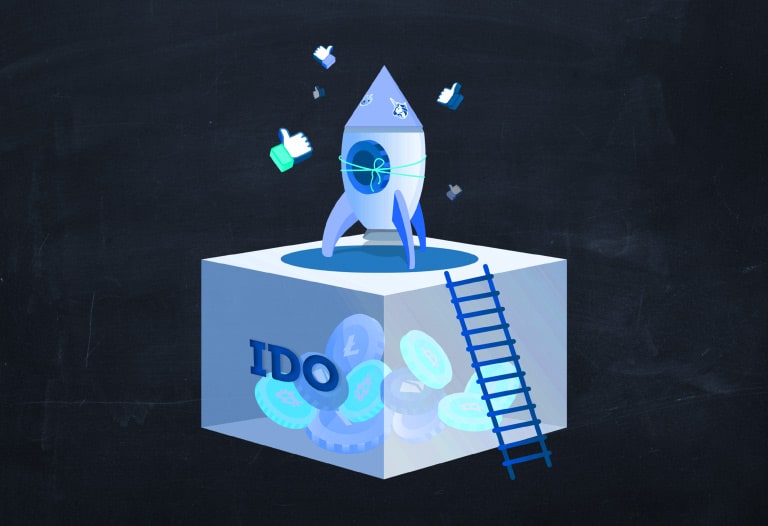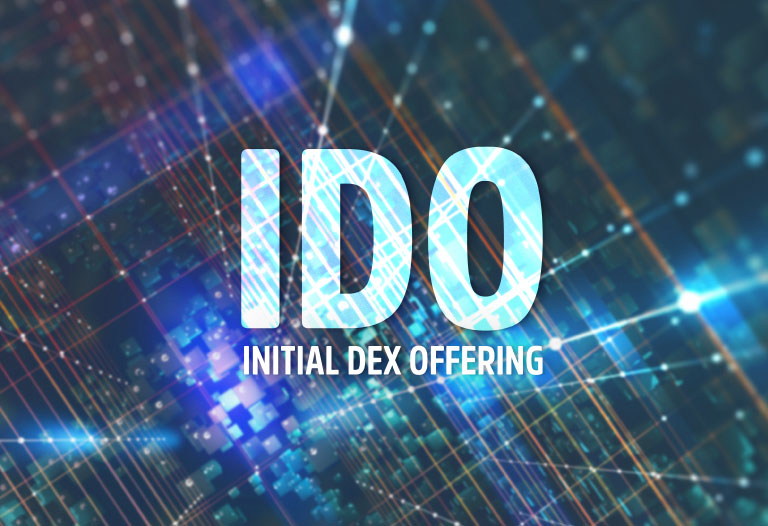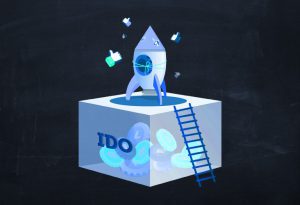
Table of Contents
ToggleThe crypto ecosystem, step by step, is finding a way to combine its tools with its own principles. Knowing what an IDO is, is to know a clear example in this sense.
Having gone through different stages in terms of financing new projects, the latest developments allow this ecosystem to be self-sufficient.
The popularization of IDOs reveals the benefits and incipient problems of decentralization as a movement. Let us review the events that led to the creation of this decentralized financing mechanism and its consequences.
What does IDO mean?
When we say IDO, we are mentioning an acronym that stands for “Initial DEX Offering”. This initial offering on a decentralized exchange is a method by which projects in need of funding are launched to obtain it by presenting a token or cryptocurrency for sale in a decentralized manner.
When referring to decentralized ways or options, we are talking about two types of platforms that support these releases:
-
- Decentralized Exchanges (e.g. Uniswap)
- Launchpads
The former are well known to us. Their role is key, since once the IDO is concluded, they are generally in charge of providing the enabling environment for these tokens to start being exchanged by users.
The second type of platform, the “Launchpads” are currently flourishing in response to the large number of IDOs being carried out. As always, the crypto world provides solutions to the needs that its own particularity generates.
However, in order to understand the emergence, purpose and functioning of IDOs, a historical review is unavoidable.
IDO’s as an evolution of ICO’s, STO’s and IEO’s.
What a tongue twister I have created, but I promise to unravel it clearly, as the succession of facts has shown us that the IDOs are nothing more than an evolution and improvement of the previous ones.
Let’s start with the first and loudest.
The vilipendiadas ICO’s
Those who lived through the era of ICOs tend to remember them with a certain dread and associate them with a time in crypto-history when projects that promised “gold and gold” and in reality only sought to make money and flee, flourished unchecked.
In “Initial Coin Offerings”, projects would set up a nice website (sometimes they didn’t even spend the money to do it), present a bombastic “White Paper” or even a “Lite Paper” and launch their token for sale.
Many projects raised capital and disappeared. But, not everything was “scams” and false promises in the ICO era. That era left us the most important blockchain, after Bitcoin. You may have guessed that I am talking about Ethereum.
In the Ethereum ICO, the most valued to date in terms of the success achieved by the project, carried out in 2014, each ETH was traded at about $0.311. Users had to send the equivalent amount in bitcoins to a wallet of that network, and in exchange they received the ETH in the nascent Ethereum network. A success by any measure.
A step forward with STOs
Many users are happy with the decentralized world until their money disappears. The cries of pain and complaint reached the ears of the regulators and the protectionist evolution of the previous model became the “Security Token Offering”.
Here we were dealing with projects that were offering a security. According to the SEC (U.S. Securities and Exchange Commission), a security is a fungible, exchangeable financial instrument used to raise money in either a public or private market.
Being covered by this entity, the tokens traded here had a legal protection that did not exist at the time of the ICOs. Exchanges wishing to trade these tokens would have to abide by all the rules proposed by this body.
IEO, the giants come into play
Undoubtedly, STOs did not represent the crypto spirit and philosophy of the ecosystem. The legal precepts, while offering some protection, were seen by the ecosystem as restrictions to flexibility and freedom.
It is for this reason that “intermediate” institutions, as exchanges can be considered, decided to enter the game and offer, among their services, the possibility of launching tokens or cryptocurrencies for sale to finance projects through IEOs (Initial Exchange Offering). Something like an ICO, but much more centralized, since the offer is controlled by the exchanges that act as trusted intermediaries.
The positive points were:
-
- Ease of user access and interaction
- Fast listing of the token on the platform
- High diffusion power
However, there is no need to delve into the ideas that blockchain purists have developed about these platforms that continue to support the “intermediation” model.
Therefore, the crypto world came up with its own solution. Let’s take a look at it.

How does an IDO work?
Now that we know the historical events that you have not deposited at this point in the crypto-evolution, perhaps the need for IDOs will become extremely clear to us.
The birth of Ethereum plus the creation and subsequent dissemination of “Smart Contracts” endowed the crypto world to create decentralized multi-purpose applications.
Making use of an existing concept, such as decentralized exchanges, but also giving life to a new one, launchpads, the ecosystem eventually replaced centralized options and made it possible to achieve on-chain financing (directly on the blockchain).
Let’s review how an IDO works.
Preparation of the IDO
Projects seeking funding to continue or start their development, contact the platforms that support this type of events and provide the required data.
It is evident that each “DEX” or “Launchpad” will handle its own parameters when approving an event of this type, but they usually coincide in the following:
- Project objectives
- Project web page
- GitHub repository
- Tokenomics
- Equipment behind, if public
- Partnerships or related investors
- Number of tokens to be offered
- Price per token unit
With this information, the platform will perform its corresponding analysis and will be able to decide on the viability of the IDO.
User preparation
As users we must, of course, be attentive to the announcements that these platforms make about the future IDO’s that they will host. On the other hand, it is also necessary to know the prerequisites to participate.
There will be several cases in which there are no requirements to participate, but we could find that the “DEX” or the “Launchpad” have their own token and their possession acts as a token:
- Requirement to participate in the IDO
- Limit for the amount of purchase in the IDO
In addition to the research of the project, this is a key point to take into account and weigh when entering an IDO. If we are obliged to invest in the “DEX” or “Launchpad” token, we would be doubling the risk, as well as the possible benefits, since we expose ourselves to the price of two tokens.
The IDO event
Most of the IDOs carried out in recent times tend to be highly orderly. We find those in which, first, a private sale takes place, for example to token holders of the launching platform, and then the public sale.
The times are established in advance, with the total sale of the tokens in question or a deadline, regardless of the amount sold, being set at certain times.
The question of price is another interesting aspect. Although the most common is to set a price in advance for each token, we have different styles when contemplating it.
Some IDOs have chosen to enable the deposit of a stable coin and place a total amount of tokens to be sold. Once the period is over, the total amount of tokens offered is divided by the total amount of deposits and thus the price for which each token was acquired is obtained.
Post-IDO
Again, each IDO, “DEX” and “Launchpad” has its usual mechanism. But, most commonly, the purchased tokens, once the IDO is finished, are immediately delivered to the users or undergo a vesting period.
When the IDO is performed in a “DEX”, once completed, the project can provide the initial liquidity for the token to start being exchanged by users. A pool is created with the token sold and, generally, a stable currency, to facilitate trading. This option is immediately made available to the purchasers of the token, who can contribute them to these pools.
When the launch takes place on a Launchpad, it is necessary that either they or the project negotiate for a DEX to offer the exchange of the token.
The advantages of IDO
This tool, born from the heart of the crypto ecosystem, provides benefits to both parties involved in this equation. They are those that we already know and that usually come hand in hand with decentralization:
- Transparency
- Information in the blockchain (on-chain)
- No need to apply for permits
From the user’s point of view, the prior curation of the project by the platform hosting the event is an extra benefit compared to the methods previously known.

The dangers of IDOs
Although we have “on-chain” information, platforms that host IDOs and carry out prior research on the projects they promote, the risks never disappear.
However grandiloquent the proposal, the code generated so far, “White Paper” or “Lite Paper”, we must not forget that we are investing in a project whose future success is not guaranteed.
It is important not to be blinded by lavish profits generated by previous IDO’s and conduct thorough research. All information at hand, should be taken into account and sifted through an exhaustive analysis prior to being part of these “Inital Dex Offering”.
Knowing the team behind them, their intentions, previous works, associations, investors that support them and also the community they generate, are just some of the necessary points to consider before turning to this type of bets.
A reflection
As I mentioned at the beginning of this article, perhaps the fact that stands out the most with respect to the existence of IDOs is the intrinsic characteristic of the crypto world to provide its own solutions.
Even if some opportunists take advantage of these tools to perpetrate their dark desires and deceive users, this ecosystem evolves respecting its principles and therein lies the true value.
New challenges, pitfalls and solutions we will be privileged to see blossom in front of our continually bewildered crypto-eyes. But as always, most importantly, this is just the beginning.








